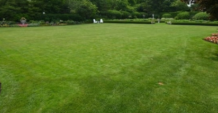Writer – Linda Geist, University of Missouri Extension
Houseplants journey inside for the winter
Your houseplants may look like they need CPR after you bring them inside to protect them from falling temperatures.
Do not despair. With proper care, plants revive and come back to full splendor, said University of Missouri Extension horticulturist David Trinklein.
Houseplants drop leaves as they acclimate to life inside. “Acclimatization” is the adaptation of a living organism to a change in its surroundings, said Trinklein. Humans do it. Animals do it. So do plants.
Most houseplants benefit from an outdoor summer respite. However, when cooler weather arrives in fall, they need to be moved back indoors, where they experience a sudden change in environment. Even the brightest indoor light pales in comparison to sunlight. When placed outdoors for the summer, plants respond to natural light with a flush of growth. Indoor lighting fails to provide enough light to maintain this growth.
The plant’s struggles show several weeks after it is brought back indoors. Just as summer tans fade, plants fade because of their new light “compensation point.” This is the light intensity at which the amount of sugars and carbohydrates (food) manufactured by the plant through photosynthesis equals the amount used by the plant during respiration.
Plants continue to grow when light levels are above the compensation point because the food made by photosynthesis exceeds the amount used by respiration. But when photosynthesis can’t make enough food to keep up with respiration, the plant stops growing and loses leaves.
To avoid leaf drop, gradually acclimate plants to their new environment. “This is accomplished by gradually moving them under lower light conditions,” Trinklein said. “For example, a plant that was outdoors for the summer might be moved to the north side of a home or placed under a deck for a week or 10 days before moving it inside.”
Once acclimated, the plant will produce “shade leaves,” which use light more efficiently than “sun leaves.” Shade leaves usually grow larger and thinner, and have lower light compensation points than sun leaves, he said. They are less photosynthetically prolific, but are better equipped to use lower amounts of light.
Houseplants purchased from retail outlets often shed some leaves when placed in an interior setting. The plants likely were produced in a nursery with high light intensity and good growing conditions. Do not be concerned about the shedding of a few leaves. “This simply indicates the plant is acclimatizing to its new environment,” said Trinklein.
Pre-acclimated plants are available commercially for interior “plantscapers.” These are usually larger plants that were acclimated in production fields or greenhouses by placing them under shade fabric to reduce the amount of light they receive. As more fabric is gradually added, more sun is blocked. Acclimated plants usually cost more, but perform better.
Growers should also consider the plant’s root system when bringing plants inside, Trinklein said. Extend the interval between watering and reduce the amount of fertilizer by half. Reducing water hardens plant foliage, making it less sensitive to the low humidity typical of indoor settings.
Don’t let plants wilt severely, but take care not to overwater houseplants when you bring them inside.
“More houseplants die from overwatering than from any other cause,” Trinklein said. “While not desirable, slight wilting is rarely fatal. At the other extreme, overwatered plants often lose their roots due to stress caused by a lack of oxygen. Plants that wilt because of root loss rarely recover and survive as attractive additions to the interior environment.”




